The Italian Aerospace Information Web
by Aeromedia - corso Giambone 46/18 - 10135 Torino (Italy)

In the picture: Front view of Agusta/Bell AB 205A-1 gate guardian of 34th Gruppo Squadroni AVES “Toro” with the “100 anni di volo italiano a Venaria Reale!” inscription. Venaria Reale Airport (Turin, Italy), November 3, 2009. (Aeromedia)
(Aeromedia, November 2009)